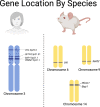Models of Renal Cell Carcinoma Used to Investigate Molecular Mechanisms and Develop New Therapeutics
- PMID: 35463327
- PMCID: PMC9022005
- DOI: 10.3389/fonc.2022.871252
Models of Renal Cell Carcinoma Used to Investigate Molecular Mechanisms and Develop New Therapeutics
Abstract
Modeling renal cell carcinoma is critical to investigating tumor biology and therapeutic mechanisms. Multiple systems have been developed to represent critical components of the tumor and its surrounding microenvironment. Prominent in vitro models include traditional cell cultures, 3D organoid models, and microphysiological devices. In vivo models consist of murine patient derived xenografts or genetically engineered mice. Each system has unique advantages as well as limitations and researchers must thoroughly understand each model to properly investigate research questions. This review addresses common model systems for renal cell carcinoma and critically evaluates their performance and ability to measure tumor characteristics.
Keywords: cell culture; microfluidics; organoid; preclinical models; renal cell carcinoma; xenograft.
Copyright © 2022 Shapiro, Virumbrales-Muñoz, Beebe and Abel.
Conflict of interest statement
DB holds equity in Bellbrook Labs LLC, Tasso Inc., Turba LLC, Salus Discovery LLC, Stacks to the Future LLC, Lynx Biosciences Inc., Flambeau Diagnostics, and Onexio Biosystems. The remaining authors declare that the research was conducted in the absence of any commercial or financial relationships that could be construed as a potential conflict of interest.
Figures




References
Publication types
LinkOut - more resources
Full Text Sources

